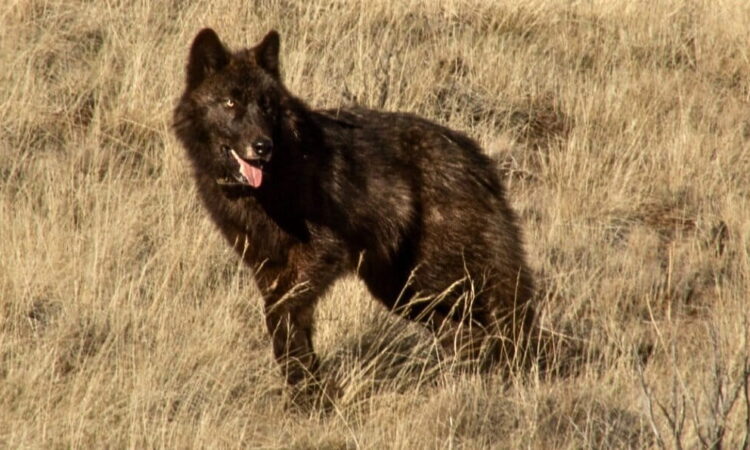
- In California, as wolf numbers grow — a remarkable return after a century — livestock producers are increasingly worried as these predators occasionally take down cattle.
- Gray wolves are an endangered species, protected under both federal and state laws, complicating the balance between conservation and economic losses, though livestock kills remain low.
- California introduced a compensation program that pays ranchers for direct and indirect losses from wolves as a way to mitigate conflicts, but ranchers say this program isn’t scalable with expanding wolf numbers. The livestock industry also receives substantial taxpayer-funded subsidies.
- Wolves were extirpated from California a century ago, so ranchers haven’t lived alongside them for generations and are pushing to remove all protections for the species. Conservationists argue coexistence is the only way forward.
This is the second part of Mongabay’s series on the expanding wolf population in California. Read the first part here.
In May 2025, five counties in northern California — mostly rural farm and ranch land — declared an unprecedented state of emergency. It wasn’t a natural disaster or civil unrest that led to panic, but rather a bunch of thriving canids — wolves, to be precise. They’d killed livestock, and according to some residents, were exhibiting “bold, abnormal behavior” and “coming too close to homes.”
Between October and December 2024, wolves killed 19 cattle in an area home to more than 300,000 cows, but the wolves are, in reality, returning to what was once their own homes.
Gray wolves (Canis lupus) roamed the Californian landscape for thousands of years until the last one was shot in the 1920s. But over the last decade, they have started recolonizing their former territories, migrating south from Oregon, and their numbers have begun to rebound with howling success. Today, between 50 and 70 wolves live in 10 packs across the state, with most concentrated in the northeast — around counties that declared a state of emergency.
Wolves, like all big carnivores, can go after livestock, but they prefer wild prey, particularly elk and deer, said Amaroq Weiss, senior wolf advocate with the Center for Biological Diversity, who has spent more than three decades studying wolves across the United States. “That’s what they evolved to eat for millions of years.”

Over the last century, farmers and ranchers moved nearly 7 million cattle into California, edging out wildlife. “After replacing all of their wild prey with cattle and sheep,” Weiss said, “the large predators really didn’t have much choice but to start eating that livestock. You know, bears did, cougars did, coyotes did, wolves did.”
But California’s ranchers haven’t lived with wolves in generations, so they haven’t adapted their ranching practices to coexist with wolves. As livestock kills slowly increase, ranchers are reacting strongly, despite the state’s attempts to compensate these losses with cash and the dairy industry being subsidized with taxpayer money.
The situation has pitted California’s wolves and people protecting them against livestock producers whose livelihoods depend on the survival of their herds. But so far, losses from wolves are just a tiny fraction of California’s cattle. The California Department of Fish and Wildlife (CDFW) has documented 142 cases of probable or confirmed cattle killed by wolves between 2015 and 2024. That is 0.002% of California’s nearly 7 million livestock.
In a changed landscape, building coexistence between people and wolves is an ongoing challenge. “The wolves have returned to a state that is no longer what it once was in terms of being wild and being able to accommodate a carnivore in the same way as in the 1920s,” said Axel Hunnicutt, a biologist who coordinates the gray wolf program for CDFW. “If we, as a people of 40 million, want wolves, it is going to cost something.”
A changed landscape has brought increased conflicts
Present-day California may be new to wolves, but these canids have prowled the state for centuries, and much of the landscape is conducive to their survival.
“California has great wolf habitat,” said Weiss, who estimates that the northern part of the state, with about 60,088 square kilometers (23,200 square miles) of ideal wolf habitat, can support “anywhere from 400 to 500 wolves.” That’s about 10 times today’s numbers.
“So, it will be important for people to learn how to coexist with them,” she said.
But that’s a challenge when people haven’t lived with wolves for a century, and eradicating predators has long been the go-to strategy.
Since the turn of the 20th century, sparsely populated California became the most populous U.S. state, swelling from about 1.5 million in 1900 to 40 million today. It’s also a leading producer of dairy and livestock, worth nearly $13 billion a year, with about 7 million cattle on some 14,000 cattle ranches, most of which are family-owned.
Wolves were wiped out across most of the U.S. through targeted killing by farmers, ranchers and indiscriminate bounties. Then, in 1967, gray wolves were added to the protected species list nationwide, making it illegal to kill them. With reintroductions and recovery programs, wolf numbers surged in many parts of the country, including the West Coast. In the 2010s, wolves from Oregon crossed the border into California, roaming the state after a century’s absence.
But that’s also meant concerns are growing among ranchers in tandem with the canid’s increasing numbers. “The return of the wolves has caused a number of concerns [for] cattle producers,” said Kirk Wilbur, vice president of government affairs at the California Cattlemen’s Association, an industry group. “The most obvious one is the threat of increased direct losses of livestock to gray wolves.”
Between January and June 2025, wolves killed at least 45 livestock, mostly in northeast California, according to the state’s wildlife agency. Losses grow each year: up from 18 in 2022 when the state had only 18 wolves to 32 in 2023 and 52 in 2024.

Hunnicutt said ranching communities are bearing the brunt of the wolves’ return. Most of them, he said, “would probably argue that they don’t want wolves because of the economic costs and the changes to … their businesses and personal lives.”
For ranchers, there are direct losses when wolves kill animals raised for meat and dairy, but there are also indirect losses. When predators are present where cattle graze, they stress the cattle, which tend to gain less weight, and pregnant cows more frequently miscarry. Specialized fencing and other deterrents that keep wolves away from cattle also eat into ranchers’ profits.
There’s also an emotional cost of living with a predator. After a wolf attack, ranchers gather what’s left on the scene: dead or severely maimed animals that must be euthanized.
Compensating ranchers’ losses
As California’s wolves expanded their range and began to prey on livestock, the state launched a three-pronged, $3 million compensation pilot program in 2021 — one of the most comprehensive anywhere in the U.S. West.
It reimburses ranchers for losses if state investigators determine that wolves were the confirmed or probable killers. Wilbur, as an industry spokesperson, praised and criticized the program. He noted that ranchers evaluate the lost animal’s worth, which is important if a producer raises a specialty breed. “I appreciate that [the state] puts the onus on the rancher to say, ‘tell us what you think this animal is worth.’” But consistent funding for the program has been a challenge, he said.
The second prong of the program reimburses ranchers for nonlethal deterrents. Hunnicutt said ranchers appreciated this the most because they could choose which method to use: employing traditional range riders out on the range with herds, hanging bright-colored scraps of fabric on fences to scare off wolves or other strategies.
Most nonlethal deterrents work for a few months before wolves become accustomed to them. Then, ranchers need to switch to other methods, which can be expensive. With sporadic state and federal funds, Wilbur said ranchers end up having to cover at least some costs to protect their livestock, a concern for those operating their ranches on thin margins.
According to California Department of Fish and Wildlife data, nearly $1.9 million of the appropriated $3 million, dispersed through 56 grants, went to fund nonlethal deterrents. “That tells you how important that is from a producer standpoint, but also how expensive it is,” Wilbur said.
The last compensation category, unique to California’s program, covers indirect losses from nearby wolf packs. “The ‘pay for presence’ idea was that if you’re ranching cattle within a wolf pack territory, you should be compensated at a certain percentage for the number of livestock that you have out there,” Hunnicutt explained.
By March 2024, the entire $3 million was paid out to 109 applicants. In 2024, the program was relaunched with just $600,000, strictly covering livestock kills. In the state’s 2025 budget, signed in July, $2 million was allocated for the compensation program.
Ranchers argue this is nowhere near enough money. Wilbur, advocating for the industry, said the cost is way higher than what is allocated. “The need is probably much larger in terms of millions, or even tens of millions,” he said, adding that he’s concerned with “the legislature’s unwillingness or inability to properly fund it.”

But CDFW’s Hunnicutt said the compensation helps the tiny fraction of ranchers who live with wolves in their backyards. “Money does not completely buy tolerance, and it doesn’t buy wolf lovers. … The state of California believes that wolves should be here and that the people that are bearing the economic brunt of it should not have to pay for it entirely.”
And other resources are available to ranchers, including the U.S. Department of Agriculture’s NCRS Livestock-Predator Interaction Management program. Nonprofits, including the Working Circle and California Wolf Foundation (CWF), have also stepped up to fill funding gaps and help ranchers with nonlethal deterrents.
Susan Dewar, founder of CWF, said her organization’s program covers verified losses that happened prior to the state’s 2021 pilot program. It also helps educate ranchers and provide grants and scholarships to researchers studying the ecological impact of wolves in California.
Counting the losses and benefits from wolves
Calculating the exact monetary loss from wolves is difficult. Since ranchers graze their cattle on vast, open rangelands for days, often unfenced, many cattle deaths go unreported. And when carcasses are decomposed, it’s difficult to determine the cause of death, Hunnicutt said, adding that wolves sometimes scavenge an already-dead cow, leaving telltale tooth marks, though they’re not the killers. There aren’t enough resources to investigate every reported case, he said. “This is where things get a little muddy.”
Many media outlets have quoted estimates from a University of California Davis study that wasn’t validated by peer review, which ascertained that a single wolf could cost ranchers anywhere from $69,000 to $162,000 in direct and indirect losses. The study focused on just three wolf packs, which scientists say is not a representative sample.
Biologists argue that these numbers are not only unverified but are greatly inflated. A May 2025 letter signed by 18 wolf biologists, including Weiss from CBD, described these numbers as “sensational” and “misleading” because wolves typically hunt in packs, making it difficult to attribute the loss to a single wolf. Touting the study as gospel when it hasn’t yet been validated, she said, “is a real breach of academic ethics.”
Scientists also point out that this calculation omits the positive economic impacts of wolves. Top predators keep ecosystems healthy by hunting fast-reproducing prey animals, such as deer and elk, which would otherwise overgraze and trample riparian habitats and ravage crops.
Fewer deer and elk also means lower deer-vehicle collisions. A 2021 study in Wisconsin found that having wolves in the landscape lowered these collisions by 24% — an economic benefit 63 times higher than the costs of livestock predation by the canids. Wolves also bring in ecotourism dollars.

Weiss offered a broader economic perspective on wolf-livestock conflict. “The livestock industry is one of the most highly subsidized industries in this country. … American taxpayers are already subsidizing these private, for-profit businesses,” she said.
According to a 2024 analysis, taxpayers subsidized the livestock industry by more than $72 billion between 1995 and 2023. The meat and dairy industries receive 63% of total agriculture subsidies — the highest of all agricultural sectors.
Killing gray wolves is not the solution
California’s ranchers are no strangers to predators, but wolves aren’t the worst of them. Data from the U.S. Department of Agriculture show that coyotes were responsible for nearly 35% of all cattle killed by predators in California in 2015. Ranchers shoot or poison these canids to save their livestock. With protected species like gray wolves, however, that’s not an option.
But in April 2025, California’s wolf conservation plan entered its second phase with seven established breeding pairs. The state is now contemplating issuing permits to use more aggressive forms of hazing, such as rubber bullets and bean bags, which can injure wolves but won’t kill them. In June, the CDFW launched a “strike team” in three counties, where wildlife officers can use these injurious techniques to drive wolves away.
Once eight breeding pairs are in a region for two consecutive years, the conservation plan enters Phase 3. California may then reevaluate endangered species protections or permit killing them in the case of conflicts. At that eight-pair threshold, Wilbur said his industry group will petition the California Fish and Game Commission for delisting.
Hunnicutt said that if state and federal laws permit, lethal removal — killing wolves — is “a potential option if necessary for the amount of conflict that’s occurring.” But the laws, so far, haven’t changed.

Just because killing wolves is illegal, it hasn’t stopped bad actors from using their guns, California Wolf Foundation’s Dewar said. “People that are anti-wolf, they have the three Ss — shoot, shovel and shut up. … People post that on social media all the time,” she said, though there’s no way to know how often it happens.
Some incidents, like one that occurred in April 2025, raise questions. A young female wolf was found dead on the side of the road in Tehama county under “very suspicious circumstances,” Dewar said, with a bloody injury on her flank resembling a gunshot wound. It’s one of a handful of cases under investigation.
Meanwhile, studies show that deterring predators is the most effective way to keep livestock safe, rather than killing them. “If you kill wolves, you could actually exacerbate the problem,” Weiss said. When pack leaders die, young wolves often lack sufficient skills to hunt elk or deer, so they prey on easier-to-kill livestock. “It is more effective and less expensive to use nonlethal conflict deterrence measures than it is to simply kill wolves over and over again,” Weiss said.
A future with wolves
While wolves enjoy tremendous public support, there’s a simmering divide between rural and urban Californians, and between those who love wolves and those who revile them. The future of the wolves in the landscape depends on how fast the divide can be bridged.
In general, urban Californians seem to be very excited about the return of wolves, Hunnicutt said, noting that people’s opinions on wolves seem to be inversely correlated with how far away they live.
Around the world, across Africa, Europe, South America and Asia, people live beside predators and have found ways to resolve conflicts with them. “We are really only limited by our human ingenuity,” Weiss said. While compensation is key to coexistence, she said, learning to coexist is the only way forward.
Europe offers a working example: In 2022, 21,500 wolves lived on a landmass almost the size of the U.S., where only 18,000 wolves live. Europe also has twice as many people as the U.S.
Ultimately, it comes down to attitudes and acceptance. “In the United States, we tend to have this idea that wildlife belongs in wilderness areas and forests, and people belong here, and the two cannot meet,” Weiss said. “That’s not correct.”
Dewar said the path California chooses for wolves can guide other parts of the country. “It really doesn’t need to be an us-versus-them issue,” she said. “It’s a great opportunity for us to become a model for other states where wolves are going to start to recolonize.”
Banner image: California is now home to nearly 70 wolves in 10 packs spread across the state. As wolf numbers increase, ranchers in the state are worried about losses to their livestock. Image Credits: Malia Byrtus for California Wolf Project
Spoorthy Raman is a staff writer at Mongabay, covering all things wild with a special focus on lesser-known wildlife, the wildlife trade and environmental crime.
Wolves’ continued spread in California brings joy, controversy & conflicts
Citations:
Sidorovich, V. E., Tikhomirova, L. L., & Jędrzejewska, B. (2003). Wolf Canis lupus numbers, diet and damage to livestock in relation to hunting and ungulate abundance in northeastern Belarus during 1990–2000. Wildlife Biology, 9(2), 103–111. doi:10.2981/wlb.2003.032
Fardell, L. L., Pavey, C. R., & Dickman, C. R. (2020). Fear and stressing in predator–prey ecology: considering the twin stressors of predators and people on mammals. PeerJ, 8, e9104. doi: 10.7717/peerj.9104
Raynor, J. L., Grainger, C. A., & Parker, D. P. (2021). Wolves make roadways safer, generating large economic returns to predator conservation. Proceedings of the National Academy of Sciences, 118(22). doi:10.1073/pnas.2023251118
Lorand, C., Robert, A., Gastineau, A., Mihoub, J., & Bessa-Gomes, C. (2022). Effectiveness of interventions for managing human-large carnivore conflicts worldwide: Scare them off, don’t remove them. The Science of the Total Environment, 838, 156195. doi:10.1016/j.scitotenv.2022.156195
FEEDBACK: Use this form to send a message to the author of this post. If you want to post a public comment, you can do that at the bottom of the page.



